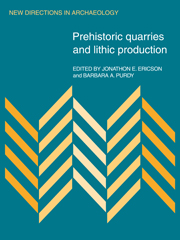Book contents
- Frontmatter
- Contents
- List of contributors
- Dedication
- Part 1 Introduction
- Part 2 Procurement, production, and exchange
- 2 Mount Jasper: a direct-access lithic source area in the White Mountains of New Hampshire
- 3 Procurement without quarry production: examples from southwestern Idaho
- 4 The 63-kilometer fit
- 5 Monopoly or direct access? Industrial organization at the Melos obsidian quarries
- 6 Lithic material demand and quarry production
- 7 Economic aspects of prehistoric quarry use: a case study in the American southwest
- 8 Preliminary report on the obsidian mines at Pico de Orizaba, Veracruz
- 9 State-controlled procurement and the obsidian workshops of Teotihuacán, Mexico
- Part 3 Technology and techniques
- Index
9 - State-controlled procurement and the obsidian workshops of Teotihuacán, Mexico
Published online by Cambridge University Press: 04 August 2010
- Frontmatter
- Contents
- List of contributors
- Dedication
- Part 1 Introduction
- Part 2 Procurement, production, and exchange
- 2 Mount Jasper: a direct-access lithic source area in the White Mountains of New Hampshire
- 3 Procurement without quarry production: examples from southwestern Idaho
- 4 The 63-kilometer fit
- 5 Monopoly or direct access? Industrial organization at the Melos obsidian quarries
- 6 Lithic material demand and quarry production
- 7 Economic aspects of prehistoric quarry use: a case study in the American southwest
- 8 Preliminary report on the obsidian mines at Pico de Orizaba, Veracruz
- 9 State-controlled procurement and the obsidian workshops of Teotihuacán, Mexico
- Part 3 Technology and techniques
- Index
Summary
The inhabitants of Teotihuacán, a major pre-Hispanic urban center, imported huge quantities of obsidian from the Sierra de las Navajas region 50 km to the northeast. Within the city this material was distributed in a highly equitable fashion among the numerous workshops. Trace-element analysis reveals that each workshop area included material from a number of distinct loci of exploitation in the source region. These data indicate that the obsidian was exploited and transported to Teotihuacán through a procurement network organized and maintained by the Teotihuacán state. With the collapse of the state about a.d. 750, the flow of Navajas material into Teotihuacán largely ceased.
Introduction
Teotihuacán, one of the two largest urban centers in the pre-Hispanic New World, lies a short distance northeast of Mexico City. At its height, about a.d. 200–600, it had a population of 150,000 and controlled much of the central Mexico region (Bernal 1966; Millon 1973). At that time it must have been importing enormous quantities of raw materials, both to supply its own huge population and to fuel the widespread trade network that it dominated. This raises a number of questions about the mechanisms involved in the exploitation and transportation of these resources. It is important to determine the role played by the Teotihuacán state in procurement, the scope and stability of the networks that were established, and the effects of these networks on the political and economic structures of both Teotihuacán and the source regions.
- Type
- Chapter
- Information
- Prehistoric Quarries and Lithic Production , pp. 97 - 106Publisher: Cambridge University PressPrint publication year: 1984
- 15
- Cited by



